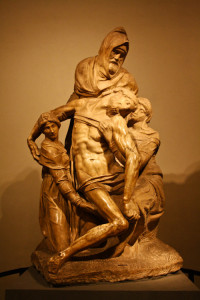
I stared for a long time at Michelangelo’s “Pietà” before noticing that Jesus was missing a leg. The statue retains such a grace, such a feeling of perfection that it left me unconcerned with such trivialities as the absence of a limb. But the work is decidedly unfinished — the figures grow out of rough, unhewn stone and dark cracks run along Jesus’ shoulder where Michelangelo attempted to shatter it in anger.
This is not the famed “Pietà” ensconced in St. Peter’s Basilica, but a later work, begun when Michelangelo was nearly 80. It is now tucked in an alcove of the Opera del Duomo museum in Florence. The piece depicts Nicodemus — sculpted as a self-portrait of Michelangelo — lowering the body of Jesus into the arms of his mother Mary and Mary Magdalene. The artist took on this work not on commission, but purely for himself as he prepared for his impending death. The piece was intended to adorn his tomb.
Michelangelo was regarded like a god even during his lifetime. His style was praised as theologically correct and an entire movement, Mannerism, was built to emulate it. In his youth, Michelangelo’s talent had been his intuition for the sculpture that a block of marble wanted to be: he could sense the shape that it contained, and believed it his task to bring that shape out of the single block. In this “Pietà” he failed — adding the leg would have thrown off the balance, introduced a dangerously racy limb entanglement between Christ and Madonna, and required additional marble. According to his contemporary biographer, Giorgio Vasari, he had been working on the sculpture by the light of a single candle, which must reasonably have contributed to the problem.
He was in the throes of an end-of-life crisis, plagued by an uncertainty with art itself and his life’s devotion to it. His world was unsteady as well, still reeling from the publication of Martin Luther’s 95 Theses some 30 years earlier. Doubt and discord had shaken the foundations of the machine that had made the very Renaissance.
Michelangelo’s other works are nearly reason enough to study in Italy; I got a crick in my neck from my inability to stop staring at the Sistine Chapel ceiling, and I am still awed by the simplicity and perfection of the “David.” But this particular work has stuck in my mind, and the image of Michelangelo’s face looking upon death is one I am not soon to forget. I cannot stop thinking of the deepness of its expression and the poignancy of the imperfect sculpture that holds it, the human struggle that it depicts and that it contained. Once I found it difficult to imagine Michelangelo as a human, but now I am beginning to understand.
– Ann Tyler Moses